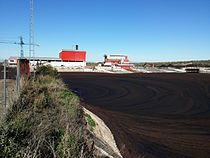Amurca is the bitter-tasting, dark-colored, watery sediment that settles out of unfiltered olive oil over time. It is also known as "olive oil lees" in English. Historically, amurca was used for numerous purposes, as first described by Cato the Elder in De Agri Cultura, and later by Pliny the Elder. [1] Cato mentions its uses as a building material (128), pesticide (91, 92, 96, 98), herbicide (91, 129), dietary supplement for oxen (103) and trees (36, 93), food preservative (99, 101), as a maintenance product for leather (97), bronze vessel (98), and vases (100), and as a treatment for firewood in order to avoid smoke (130). [2]

References
- ^ Pliny, John Bostock; Henry Thomas Riley (1856). The Natural History of Pliny: Amurca of Olives – Twenty-one Remedies. p. 486.
- ^ "LacusCurtius • Cato on Agriculture — Sections 126‑134".
External links
- Cato the Elder on Agriculture
- Olives in Antiquity (Smith's Dictionary, 1875)
- Forerunners of Pesticides in Classical Greece and Rome
![]() This article incorporates text from a publication now in the
public domain:
Chambers, Ephraim, ed. (1728). "Amurca".
Cyclopædia, or an Universal Dictionary of Arts and Sciences (1st ed.). James and John Knapton, et al.
This article incorporates text from a publication now in the
public domain:
Chambers, Ephraim, ed. (1728). "Amurca".
Cyclopædia, or an Universal Dictionary of Arts and Sciences (1st ed.). James and John Knapton, et al.